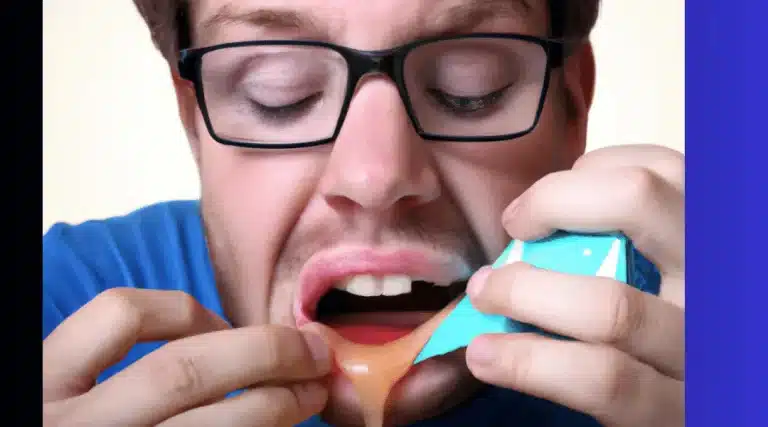Are you tired of struggling to remove denture adhesive from your mouth? If so, you’re not alone. Many denture wearers face this frustrating problem on a daily basis.
The good news is that there are several effective solutions you can try to get rid of that stubborn adhesive once and for all. In this article, we’ll explore some practical tips and tricks for removing denture adhesive from your mouth.
From rinsing with warm water to using a commercial adhesive remover, we’ll cover a wide range of options to help you find the method that works best for you. With these simple yet effective techniques, you’ll be able to enjoy the freedom of wearing dentures without the hassle of dealing with leftover adhesive.
Rinse Your Mouth with Warm Water
Time to give your mouth a refreshing rinse with warm water! Not only does warm water feel good on your mouth, but it also has benefits for your oral health.
Warm water can help to loosen and remove any leftover denture adhesive from your mouth. Plus, staying hydrated is important for denture wearers since dentures can cause dry mouth.
So, by rinsing your mouth with warm water, you’re not only removing the adhesive but also keeping your mouth hydrated.
Now that you’ve rinsed your mouth, it’s time to try a natural solution to remove any remaining adhesive.
Try a Natural Solution
Ease the sticky feeling in your oral cavity like a gentle breeze blowing through a field of flowers by opting for a natural solution.
Herbal remedies and DIY solutions can effectively remove the denture adhesive residue from your mouth. One popular option is using a mixture of baking soda and water, which can create a paste that you can apply to your gums and around the dentures.
Another alternative is rubbing a small amount of coconut oil on your gums to dissolve the adhesive. Moreover, you can try rinsing your mouth with a solution of apple cider vinegar and water to break down the adhesive’s stickiness.
These natural solutions are safe, affordable, and can be found in your kitchen or pantry. However, if the adhesive residue persists, you may need to use a commercial adhesive remover.
Use a Commercial Adhesive Remover
If you’re struggling with pesky residue that just won’t budge, it may be time to try a commercial adhesive remover for a quick and effective solution. These solvent based products are specifically designed to break down the adhesive, making it easy to remove from your mouth.
When choosing a remover, keep in mind that alcohol-free options are gentler on your skin and less likely to cause irritation. To use, simply apply the remover to a cotton ball or soft cloth and gently rub it onto the affected area. Be sure to follow the product instructions carefully and rinse your mouth thoroughly afterwards.
For a more natural option, consider applying petroleum jelly to the affected area and gently massaging it in to break down the adhesive. With these tips, you’ll be able to remove denture adhesive from your mouth with ease.
Apply Petroleum Jelly
Smooth on a dab of petroleum jelly to your gums and massage it in to help dissolve the pesky residue left behind by denture adhesive. Petroleum jelly is a great alternative to commercial adhesive removers because it’s readily available and inexpensive. However, it may not work as effectively as other methods, and it can leave a greasy feeling in your mouth.
If you do choose to use petroleum jelly, be sure to rinse your mouth thoroughly with warm water afterwards. If this method doesn’t work for you, there are other home remedies you can try, such as using a mixture of baking soda and water or soaking your dentures in vinegar.
Once you’ve removed as much adhesive as possible, it’s time to move on to the next step: use a toothbrush or tongue scraper to clean your mouth and eliminate any remaining residue.
Use a Toothbrush or Tongue Scraper
Now it’s time to give your gums and tongue a good scrubbing with a toothbrush or tongue scraper to ensure a fresh and clean feeling in your oral cavity. While both are effective, using a toothbrush can be more gentle on your gums and teeth.
Start by wetting your toothbrush and gently brushing your gums, tongue, and the roof of your mouth. Make sure to use a soft-bristled toothbrush to avoid irritation.
Alternatively, you can use a tongue scraper to remove any remaining adhesive and bacteria from your tongue. Benefits of tongue scraping include improved breath, reduced bacteria in the mouth, and improved taste sensation.
Once you’ve finished brushing or scraping, rinse your mouth with warm water to remove any remaining adhesive. Remember to be gentle while brushing or scraping to avoid causing any discomfort or damage to your mouth.
Now, it’s important to visit your dentist to ensure that your dentures fit properly and to discuss any concerns you may have about denture adhesive.
Visit Your Dentist
To ensure the health and longevity of your dentures, it’s essential that you schedule regular appointments with your dentist. A dental checkup will not only assess the fit of your dentures but also the overall health of your mouth.
Your dentist can also give you specific advice on how to maintain an effective oral hygiene routine, which can help prevent adhesive buildup. Neglecting regular dental checkups and proper oral hygiene can lead to a buildup of adhesive that can be difficult to remove, causing discomfort, and potential damage to your dentures.
By prioritizing your dental health, you can ensure a comfortable and secure fit for your dentures. Moving forward, let’s explore some tips for preventing adhesive buildup.
Tips for Preventing Adhesive Buildup
Keeping your dentures feeling fresh and comfortable is important, and there are easy ways to prevent buildup of excess material between your dentures and gums.
Firstly, making dietary changes can help reduce the amount of adhesive needed. Avoiding sticky foods and opting for softer, easier-to-chew options can decrease the need for excessive adhesive.
Secondly, establish a cleaning routine for your dentures and mouth. Brushing your gums and tongue, and rinsing with mouthwash can help remove any residual adhesive. Additionally, soaking your dentures in a solution specifically designed for denture cleaning can help prevent buildup.
Finally, always follow the instructions provided by your dentist and denture adhesive manufacturer. Proper usage and maintenance can help prevent excess adhesive buildup and keep your dentures feeling comfortable and secure.
By following these simple steps, you can ensure that your dentures stay in place without the discomfort of adhesive buildup.
Conclusion
Congratulations! You’ve successfully removed the denture adhesive from your mouth. Your smile is now free from the gummy feeling and uncomfortable residue.
As you reflect on the experience, you realize the importance of taking care of your dental health. Just like removing the adhesive, taking care of your teeth and gums requires consistent effort. It’s like tending a garden. You need to water it, prune it, and provide nourishment for it to flourish.
Likewise, you need to brush and floss daily, visit your dentist regularly, and avoid harmful habits like smoking. By doing so, you can maintain a healthy and beautiful smile for years to come.
Remember, removing the denture adhesive is just one step in your dental care routine. Keep practicing good oral hygiene habits, and you’ll be rewarded with a healthy, radiant smile. So go ahead and show off your pearly whites with confidence!




